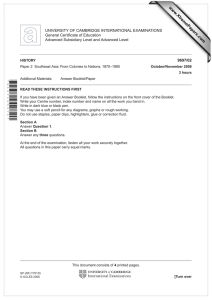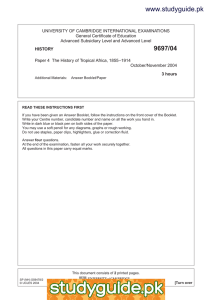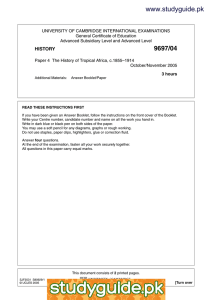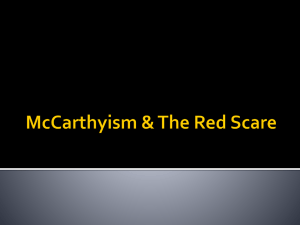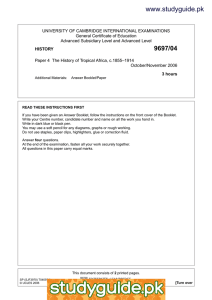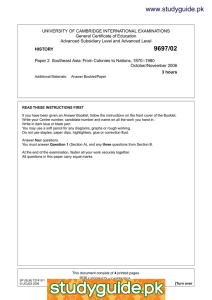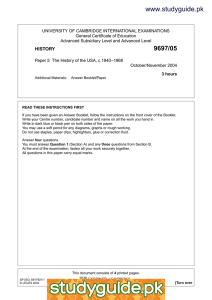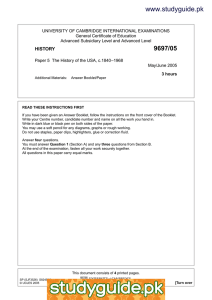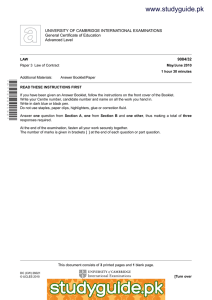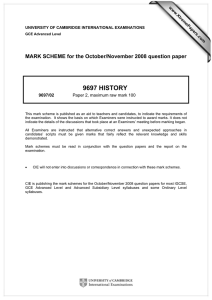www.studyguide.pk
advertisement
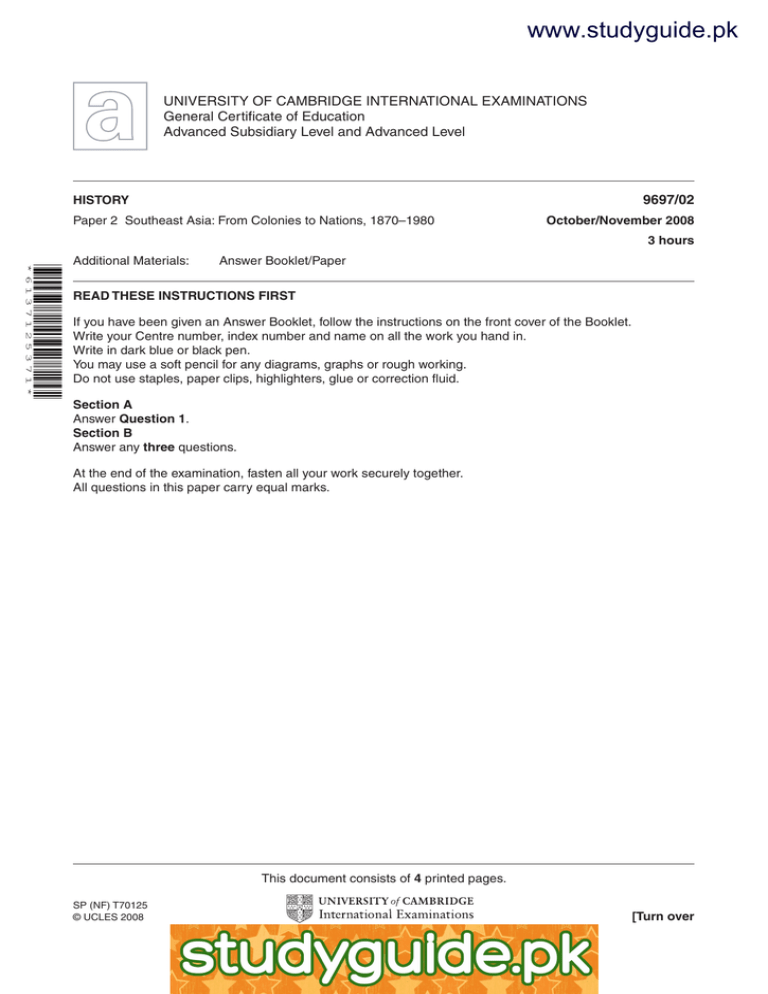
www.studyguide.pk UNIVERSITY OF CAMBRIDGE INTERNATIONAL EXAMINATIONS General Certificate of Education Advanced Subsidiary Level and Advanced Level HISTORY 9697/02 Paper 2 Southeast Asia: From Colonies to Nations, 1870–1980 October/November 2008 3 hours *6137125371* Additional Materials: Answer Booklet/Paper READ THESE INSTRUCTIONS FIRST If you have been given an Answer Booklet, follow the instructions on the front cover of the Booklet. Write your Centre number, index number and name on all the work you hand in. Write in dark blue or black pen. You may use a soft pencil for any diagrams, graphs or rough working. Do not use staples, paper clips, highlighters, glue or correction fluid. Section A Answer Question 1. Section B Answer any three questions. At the end of the examination, fasten all your work securely together. All questions in this paper carry equal marks. This document consists of 4 printed pages. SP (NF) T70125 © UCLES 2008 [Turn over www.xtremepapers.net www.studyguide.pk SECTION A: The Political Development of Singapore, 1945–65 You must answer Question 1. THE COMMUNIST FACTION WITHIN THE EARLY PAP 1 Read the Sources, and then answer the question. When answering Question 1, candidates are advised to pay particular attention to the interpretation and evaluation of the Sources both individually and as a group. Source A The People’s Action Party (PAP) was to be consciously radical and anti-colonial. We understood that Communists and their supporters would be admitted into the ranks of the party in a united front for the struggle for independence against the Bri­tish; hence Samad Ismail’s presence. We were riding a tiger and we knew it. No non-Communist faction in any united front of the Communists had ever emerged in one piece, let alone retained its grip over the united front organisation. Hence many political correspondents believed we were more knaves than fools. For how could a bunch of armchair cri­tics of British colonialism hope to stay in charge of events when they went into an unequal partnership with agents of the Malayan Communist Party (MCP), a party secretly organised by two Comintern agents sent from Shanghai in 1923, a party that the British Colonial Government could not eradicate before the war, a party hundreds of whose members were released from prisons in Singapore in January 1942 as the Japanese Imperial Army closed in on the city? From a popular history of the PAP, published by the party’s central executive committee in 1979. Source B Lee expected the Communists within the party ranks to make attempts to capture the party and he will agree that once they nearly did. What might have happened to the PAP had not Tun Lim Yew Hock, then Chief Minister, stepped in and arrested half the PAP Committee on the grounds that they were Communists, will never be known. Lee was confident they would have been outmanoeuvred, and they were, when he refused to carry on as Secretary-General unless he was backed up by a committee in which he could have full confidence. Lee was never prepared to become the tool of the Communists, as David Marshall, the unfortunate first Chief Minister, became until the Communists discarded him as a useless instrument in the 1963 general elections. From a biography of Lee Kuan Yew written with his collaboration in 1968. © UCLES 2008 9697/02/O/N/08 www.xtremepapers.net www.studyguide.pk Source C The problem for the moderates was to avoid having the party captured from below. This looked increasingly problematic. Singapore was seething with left-wing and nationalist activism. There were riots in 1954 against registering for the army draft; 1955 saw the Hock Lee Bus Riots; and there was violence during student sit-ins in 1956. Inside the party, the pro-Communists captured four out of 12 seats on the party’s executive committee, and demanded that in future the branches, already under their control, nominate candidates to the executive committee. At the fourth party conference in August 1957, the pro-Communists made an all-out bid to take over the party by stacking the conference with non-members holding phoney membership cards. They won six of the 12 executive committee seats, and had expected to win more. The moderates refused to take office to deny legitimacy to the coup. It is unclear what more the moderates could have done beyond this. But fate intervened. Nine days after the PAP party elections, the Lim Yew Hock government arrested 35 pro-Communists for subversion, including five members of the PAP executive committee and 11 branch officials. Although Lee states that Lim Yew Hock’s actions were intended to save his own support base rather than assist the PAP moderates, actually he greatly helped them. The moderates quickly set up an emergency council and held a special party conference in October 1957 to elect a new executive, now called the Central Executive Committee (CEC), and to take steps to regain and maintain control of the party by creating a new category of cadre membership, by instituting a bloc voting system for CEC candidates, and by re-registering members. From an academic history of Singapore written in the 1990s. Source D The civil unrest was the ugly side of Singapore’s bitter battle against British colonialism and of the grim struggle for independence. The country was in the midst of a historic political transition and the price was heavy. Two main forces were involved in the common cause – the Non‑Communists and the Communists. While the Non-Communists used constitutional methods, the Communists employed rough tactics in an attempt to topple the government. They agitated and mobilised workers and students, through united front organisations, to create an atmosphere of fear and tension. It was their time-tested means of starting a revolution. Lee knew that many of the trade unions that had sprouted up in post-war Singapore to fight unenlightened and tight-fisted employers were Communist united front organisations, like the powerful Singapore Factory and Shop Workers’ Union. The Secretary-General was Lim Chin Siong, a comrade of Fong Swee Suan from Malaya. Together they had led secret cells in Singapore Chinese High School in 1950. The Communists also infiltrated the non-Communist unions, as well as student bodies, and used them to stir up anti-colonial feelings and create nationwide havoc. Lee met many of the trade union and student leaders and some, like Lim Chin Siong, Fong Swee Suan, C V Devan Nair and James Puthucheary, joined him in the common cause to bring down the British. From a memoir written by a PAP activist published in the 1990s. Now answer the following question. ‘There was never any real prospect of the Communists taking over the PAP.’ How far do Sources A–D support this statement? © UCLES 2008 9697/02/O/N/08 www.xtremepapers.net [Turn over www.studyguide.pk SECTION B You must answer three questions from this section. You must support each answer with examples drawn from at least three countries. 2 ‘In economic terms, Asian peoples were better off under colonial domination than they had been before.’ How far do you agree with this judgement? 3 Why was it that colonial regimes encouraged the development of plural societies? 4 How far did the Japanese achieve their aim of a ‘Greater East Asia Co-Prosperity Sphere’ from 1941 to 1945? 5 How effectively did colonial governments respond to the rise of Nationalism in Southeast Asia up to World War Two? 6 Examine the influence of the superpowers over decolonisation in Southeast Asia after World War Two. [You must not use examples drawn from Singapore to support your answer.] 7 How far has it been state participation that has determined economic success or failure in newlyindependent Southeast Asian states? [You may refer to Thailand in your answer.] 8 Assess the causes of rivalry and conflict between the newly-independent states of Southeast Asia. [You may refer to Thailand in your answer.] Copyright Acknowledgements: Source A Source B Source C Source D © People’s Action Party. Alex Josey; Lee Kuan Yew ; Donald Moore Press; 1968. Copyright © Alex Josey. © Ernest C. T. Chew (Editor), Edwin Lee (Editor); A History of Singapore ; OUP Australia and New Zealand; 1991. © People’s Action Party. Permission to reproduce items where third-party owned material protected by copyright is included has been sought and cleared where possible. Every reasonable effort has been made by the publisher (UCLES) to trace copyright holders, but if any items requiring clearance have unwittingly been included, the publisher will be pleased to make amends at the earliest possible opportunity. University of Cambridge International Examinations is part of the University of Cambridge Local Examinations Syndicate (UCLES), which is itself a department of the University of Cambridge. © UCLES 2008 9697/02/O/N/08 www.xtremepapers.net
